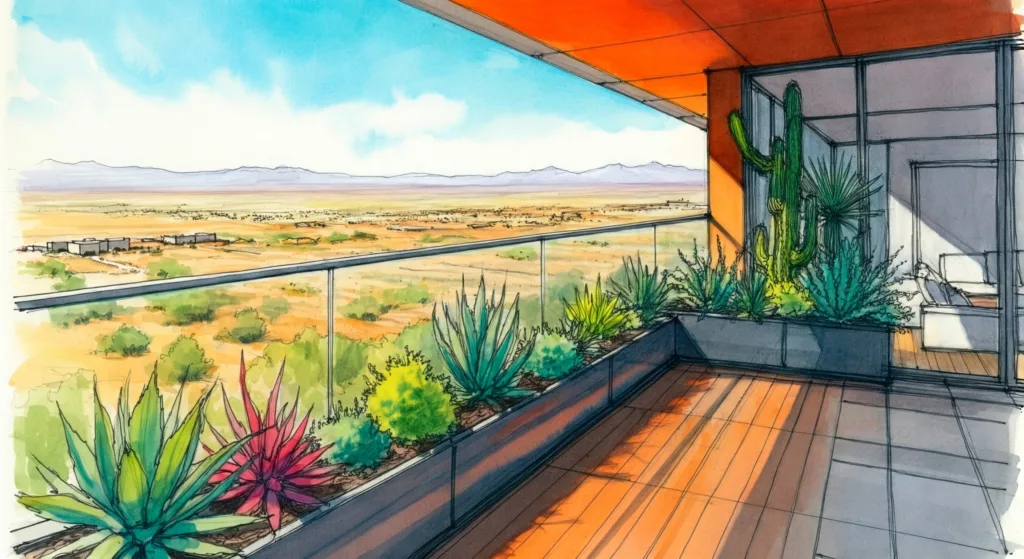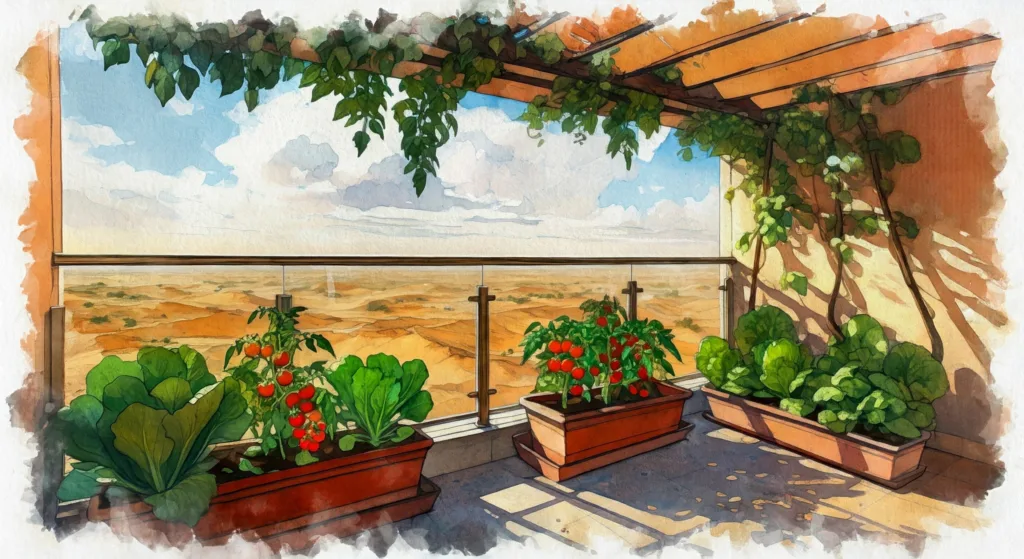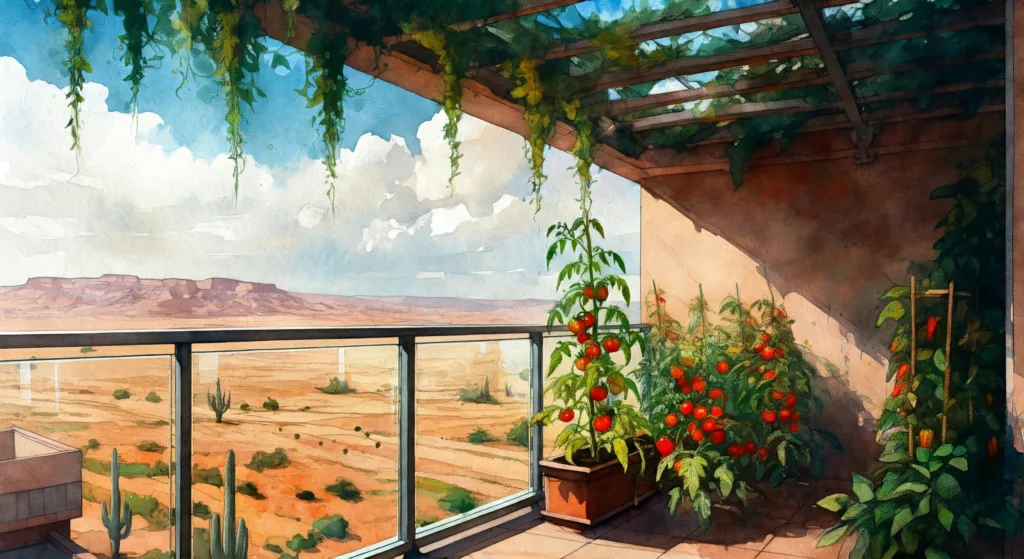Balconies, an architectural feature often taken for granted, have become increasingly underutilized in modern urban living. In Cairo, this trend is particularly pronounced. Despite the potential for balconies to offer respite from the city’s bustle and provide valuable outdoor space, many remain neglected due to a confluence of factors. Challenging weather conditions, including intense solar radiation and dust storms, coupled with suboptimal design choices and unfavorable orientations, often render these spaces inhospitable. Furthermore, the noise, dust, and glare inherent to Cairo’s streetscape further discourage balcony use.
However, the potential for these neglected spaces to be transformed into vibrant green havens is immense. Imagine Cairo’s skyline punctuated by verdant balconies, offering residents a private oasis amidst the urban clamor. This transformation not only enhances the aesthetic appeal of the city but also contributes to improved air quality, reduced urban heat island effect, and increased biodiversity. Moreover, by strategically incorporating plant life, residents can mitigate the challenges posed by excessive sunlight and noise pollution, creating comfortable and inviting outdoor spaces.
This article delves into the potential of balcony greening in Cairo, exploring the various factors that influence plant selection and design considerations. We will examine the unique challenges and opportunities presented by Cairo’s climate and urban environment, offering practical guidance on transforming balconies into thriving ecosystems. From selecting appropriate plant species for different orientations and sun exposures to incorporating sustainable materials and water-efficient irrigation systems, this guide will equip homeowners with the knowledge and tools necessary to reclaim their balconies and contribute to a greener, more livable Cairo.
The Untapped Potential of Balcony Greening

While balconies are often perceived as mere extensions of indoor living spaces, their potential extends far beyond providing a platform for potted plants. By thoughtfully integrating greenery, balconies can be transformed into dynamic ecosystems that provide numerous benefits:
- Improved Air Quality: Plants act as natural air filters, absorbing pollutants such as carbon dioxide, nitrogen oxides, and particulate matter, thereby improving the air quality in and around the home (1).
- Mitigation of Urban Heat Island Effect: Urban areas tend to experience higher temperatures than surrounding rural areas due to the abundance of heat-absorbing surfaces like concrete and asphalt.1 Plants help to mitigate this effect through evapotranspiration, a process that cools the surrounding air (2).
- Enhanced Biodiversity: Green balconies can provide habitat and food sources for various species of birds, insects, and pollinators, contributing to urban biodiversity (3).
- Noise Reduction: Strategically placed plants can help to absorb and deflect sound waves, reducing noise pollution from traffic and other urban sources (4).
- Psychological Well-being: Studies have shown that exposure to nature, even in small doses, can reduce stress, improve mood, and enhance cognitive function (5).
Challenges and Opportunities in Cairo’s Context
Cairo presents a unique set of challenges and opportunities for balcony greening. The city’s hot, arid climate, coupled with high levels of air pollution and dust, necessitates careful plant selection and design considerations.
- Intense Solar Radiation: Cairo experiences long hours of intense sunlight, particularly during the summer months. This requires selecting plant species that can tolerate full sun and drought conditions.
- Water Scarcity: Water conservation is crucial in Cairo’s arid environment. Implementing water-efficient irrigation systems, such as drip irrigation or rainwater harvesting, is essential for sustainable balcony gardening.
- Dust and Air Pollution: Cairo’s air quality can be compromised by dust storms and vehicular emissions. Choosing plants that are tolerant of these conditions and incorporating features that help to filter the air, such as green walls or vertical gardens, can be beneficial.
- Limited Space: Balconies in Cairo are often small, requiring creative space utilization and vertical gardening techniques to maximize the green area.
Despite these challenges, Cairo’s climate also offers opportunities for year-round gardening. The mild winters allow for the cultivation of a wide variety of plants, and the abundance of sunlight provides ample energy for photosynthesis.
Plant Selection and Design Considerations

Selecting the right plants is crucial for successful balcony gardening in Cairo. Factors to consider include:
- Orientation: South-facing balconies receive the most sunlight and are suitable for sun-loving plants. North-facing balconies receive less direct sunlight and are better suited for shade-tolerant species. East- and west-facing balconies receive a mix of sun and shade throughout the day.
- Sun Exposure: Plants have varying sunlight requirements. Some thrive in full sun, while others prefer partial shade or full shade. Matching the plant’s needs to the balcony’s sun exposure is essential.
- Water Requirements: Choose plants that are drought-tolerant and can withstand periods of water scarcity.
- Growth Habit: Consider the plant’s growth habit and mature size. Vining plants can be trained to climb trellises or walls, maximizing vertical space. Compact plants are suitable for smaller balconies.
- Maintenance: Select plants that require minimal maintenance and are well-suited to Cairo’s climate.
In addition to plant selection, design considerations play a vital role in creating functional and aesthetically pleasing balcony gardens. Incorporating elements such as seating, lighting, and water features can enhance the usability and enjoyment of the space.
The following table provides a selection of drought-resistant plants suitable for different balcony orientations in Cairo, considering their root system characteristics and soil depth requirements:
| Plant Name | Orientation | Benefits | Root System | Soil Depth (mm) | Mature Size | Growth Habit |
| Bougainvillea spectabilis | South, West | Vibrant bracts, drought-tolerant, attracts pollinators | Shallow, spreading | 40-60 | 3-10m tall, spreading | Vine/Shrub |
| Jasminum sambac (Arabian Jasmine) | South, East, West | Fragrant white flowers, climbing habit, creates shade | Moderate | 50-80 | 1-3m tall, climbing | Vine |
| Hibiscus rosa-sinensis (Chinese Hibiscus) | South, East | Showy flowers, attracts pollinators, tolerates heat | Moderate | 60-100 | 2-5m tall, bushy | Shrub |
| Pelargonium x hortorum (Zonal Geranium) | South, East, West | Colorful flowers, drought-tolerant, low maintenance | Shallow | 30-50 | 30-60cm tall, spreading | Shrub/Ground cover |
| Lavandula angustifolia (English Lavender) | South | Aromatic foliage, purple flowers, drought-tolerant, attracts pollinators | Deep, but adaptable | 40-60 | 60-90cm tall, bushy | Shrub |
| Rosmarinus officinalis (Rosemary) | South | Aromatic foliage, culinary herb, drought-tolerant | Deep, but adaptable | 40-60 | 1-2m tall, upright | Shrub |
| Sedum spp. (Stonecrop) | South, West | Variety of forms and colors, drought-tolerant, low maintenance | Shallow | 20-40 | 5-30cm tall, spreading | Ground cover |
| Nephrolepis exaltata (Boston Fern) | North, East | Adds greenery in shaded areas, tolerates humidity | Shallow | 30-50 | 60-90cm tall, arching fronds | Fern |
| Chlorophytum comosum (Spider Plant) | North, East, West | Air-purifying, easy to propagate, tolerates low light | Shallow | 30-50 | 30-60cm tall, spreading | Ground cover |
| Sansevieria trifasciata (Snake Plant) | North, East, West | Air-purifying, low maintenance, tolerates neglect | Shallow | 30-50 | 60-120cm tall, upright | Shrub |
| Epipremnum aureum (Golden Pothos) | North, East, West | Trailing foliage, air-purifying, low maintenance | Shallow | 30-50 | 2-10m long, trailing | Vine |
Materials and Sustainability
Choosing sustainable materials for balcony construction and furnishings is essential for minimizing environmental impact. Recycled or reclaimed materials, such as wood or metal, can be used for flooring, railings, and furniture. Locally sourced materials reduce transportation costs and support the local economy.
Incorporating energy-efficient features, such as solar-powered lighting or shading devices, can further enhance the sustainability of the balcony. Rainwater harvesting systems can be implemented to collect and store rainwater for irrigation, reducing reliance on municipal water sources.
Utilizing Air Conditioner Condensate for Irrigation
In a city like Cairo, where water conservation is paramount, exploring alternative water sources for irrigation becomes crucial. One such source, often overlooked, is the condensate produced by air conditioning units. With millions of AC units operating throughout the city, the cumulative volume of condensate generated represents a significant potential for water reuse.
Air conditioner condensate is essentially distilled water, formed as the warm, humid air comes into contact with the cold coils within the AC unit. This condensation process removes impurities, resulting in relatively clean water suitable for irrigation. While the water may contain trace amounts of minerals or metals depending on the specific unit and environmental conditions, it is generally safe for most plants.
Collecting condensate is a straightforward process. Simple collection trays can be placed beneath the AC unit’s drainage outlet to capture the water. Alternatively, the drainage pipe can be connected to a larger storage container for increased capacity. For those seeking a more integrated solution, commercially available condensate collection systems offer features such as filtration and automatic overflow prevention.
Before using condensate for irrigation, it’s advisable to observe the water for any unusual color or odor. If concerns about water quality arise, simple filtration methods can be employed. Additionally, it’s important to monitor plant health after initial watering with condensate to ensure they are responding well.
Integrating condensate collection with existing irrigation systems can further enhance water efficiency. The collected water can be used to supplement other water sources, reducing reliance on municipal water supplies. This not only contributes to water conservation but also lessens the environmental impact associated with water treatment and distribution.
By harnessing this readily available and often-wasted resource, Cairo’s residents can significantly reduce their water footprint and contribute to a more sustainable urban environment. The utilization of air conditioner condensate exemplifies how innovative approaches to water management can transform everyday practices into eco-conscious solutions.
Conclusion

Transforming Cairo’s balconies into green havens offers a multitude of benefits, from improving air quality and mitigating the urban heat island effect to enhancing biodiversity and promoting psychological well-being. By carefully considering plant selection, design elements, and sustainable practices, homeowners can create vibrant and functional outdoor spaces that contribute to a greener, more livable city. This initiative not only reclaims underutilized spaces but also empowers residents to actively participate in creating a more sustainable urban environment.
References:
- Escobedo, F. J., et al. “Cooling cities through urban green infrastructure: a critical review of the benefits and challenges.” Urban Forestry & Urban Greening 14.3 (2015): 599-619.
- Zölch, T., et al. “Urban green space cooling effect in cities.” Urban Ecosystems 20.1 (2017): 1-33.
- Goddard, M. A., et al. “A global synthesis of the roles and benefits of urban trees for environmental management.” Environmental Reviews 23.2 (2015): 139-161.
- Fang, C. F., and Ling, D. L. “Investigation of the noise reduction provided by tree belts.” Landscape and Urban Planning 85.3-4 (2008): 166-172.
- Ulrich, R. S. “View through a window may influence recovery from surgery.” Science 224.4647 (1984): 420-421.

